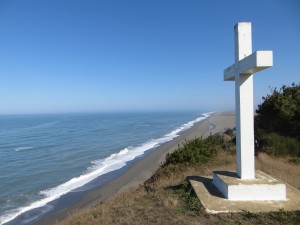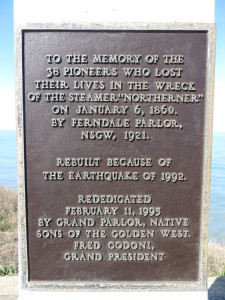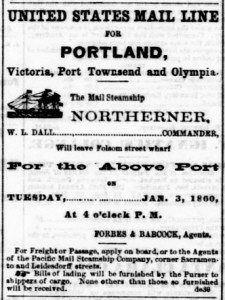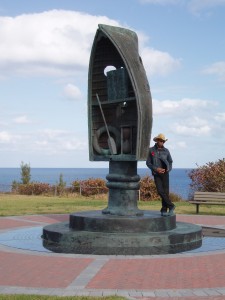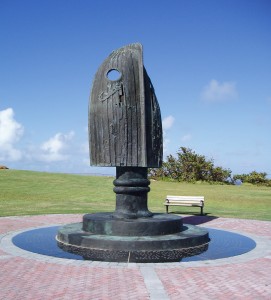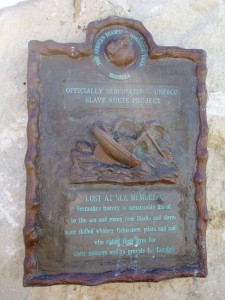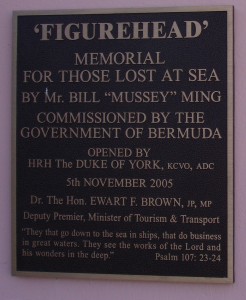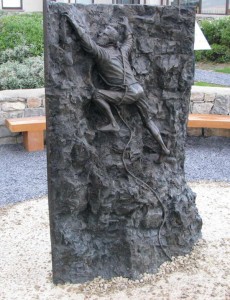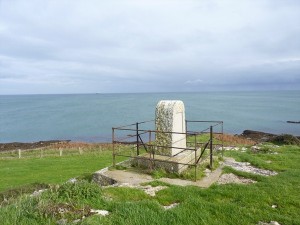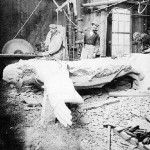Archive for the 'Passenger Liners' Category
My favorite Lost at Sea memorials are the ones found off the beaten track. Centerville Beach is located north of Cape Mendocino, approximately five miles west of the village of Ferndale. The beach is nine miles long, with sweeping vistas of the Pacific to the west and the redwoods to the east. On most days you’re likely to have the entire beach to yourself. On a tall bluff overlooking the beach is a tall white cross, a monument to the steamship SS Northerner, lost on January 6, 1860.
The Northerner was built in 1847 in New York City. She spent her first few years serving the east coast of the United States, but eventually moved to San Francisco, where she established a regular passenger and mail route from San Francisco to the Columbia River and north to Washington. Her last voyage from San Francisco ended when she hit a submerged rock just a few miles offshore from Centerville Beach. The ship was carrying 108 persons at the time of the wreck. 70 people were saved, mostly due to the heroic efforts of the local citizens living around Ferndale. 38 others perished. Some bodies were eventually recovered and buried on a bluff overlooking the site of the wreck. Other victims were lost to the Pacific…
In 1921 a white cross monument was built directly above the burial site of the recovered dead. The original monument was destroyed in an earthquake centered in Cape Mendocino in 1991. Local residents rebuilt the monument and it was rededicated on February 11, 1995. It serves as a stark reminder of the dangers of ocean travel – and as a memorial to lives lost at sea in this remote and most beautiful area.
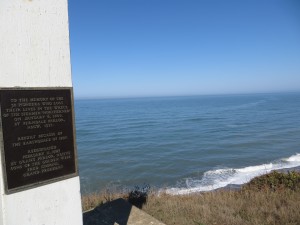
The most enjoyable and satisfying aspect of writing this blog is hearing from strangers commenting on a post or directing my attention to a memorial previously unknown to me. Recently I received an email from Nadia Ming, calling my attention to the Figurehead Memorial on St. David’s Island, Bermuda. My sincere appreciation to her for all the background information for this post. All Photographs in the post are courtesy of Nadia Ming.
The memorial was originally proposed in January 2003, when two fishermen were lost at sea in rough weather. The memorial, by Bermuda artist and native Bill Ming, was dedicated on November 5, 2005 by HRH Prince Andrew, the Duke of York.
I often speculate about the thought process of the artist when writing these posts. This post is special, however, as Nadia Ming provided me with Bill’s original vision for the project.
Maquette for Memorial for Those Lost at Sea
“As an ex-seaman who worked aboard the Queen of Bermuda I felt inspired and motivated to submit my representation of the Memorial for Those Lost at Sea. The theme of maritime life is very close to my art and ideas therefore this sculpture is intended to be a work of commemoration for the known and unknown souls lost to the tides of time yet alive through our memories and chronicles.
This memorial should honour our local fishermen/women who cast their nets and pots to scrape an existence from their catch. Bermudians lost to their loved ones as a result of storms or hurricane and the African slaves who perished during the long arduous Middle Passage.
I have tried to capture these elements, creating the spirit of a beacon that acts as a guiding and welcoming sight in times of storm and calm, a lookout for sailors who sail beyond that horizon of hope.
The form of my sculpture takes the shape of an upturned vessel, which points to the skies and stands erect on a compass due east. Barnacles, shells and a map of Bermuda tattoo the face/mask like limpets clinging to a hulks underbelly. These would stand proud of the surface providing tactile information for people with visual impairments.
Braids of rope frame a cabinet, which houses a paddle for that proverbial creek; an hourglass with sand running out and a life preserver to keep ones head above the water. Overseeing these articles shelters an open logbook that can display the names of all ”Bermudians lost at sea,” alternatively the base could also provide space for names, which would be visually accessible for people in wheelchairs.
I envisage that the final design could be produced in metal (possibly bronze) and/or stone, which would be sympathetic to the site and have durability.”
I believe Mr. Ming captured every element he envisioned in this beautiful memorial. The artist is pictured in the first picture below. I encourage everyone to learn more about Mr. Ming and his art at: http://www.billming.com/index.php
Nadia pointed out two very important additional elements of the memorial in her emails. The first was that The Figurehead Memorial is also part of The African Diaspora Heritage Trail (ADHT), which has been officially designated part of UNESCO Slave Route Project. Take the time to visit the ADHT website at: http://www.adht.bm. I think you will find yourself, like me, spending many fascinating hours learning about “the global narrative of people and culture of African descent” – and the very valuable and important effort to encourage everyone to visit these sites of historical and cultural importance and enrichment.
Information on the UNESCO Slave Route Project can be found at :http://www.unesco.org/new/en/culture/themes/dialogue/the-slave-route.
Men and women of African descent have sailed the oceans since the beginning of recorded history. The earliest known ocean voyages were from Northern Africa to Malta and Crete. During the Great Age of Sail (1600 – 1850) over 20% of all able-bodied seamen were of African descent – some were slaves, but most were free Blacks. Today they still command and crew the warships, merchant vessels, passenger ships and fishing fleets of the world – and daily face the dangers and the majesty of the open ocean.
Approximately 70 names of those lost at sea from Bermuda are engraved at the base of the memorial. All their names can be found at: http://bernews.com/2010/03/lost-at-sea-memorial-full-list-of-names/.
In closing this post, the poem below is inscribed in the open pages of the logbook on the memorial. The poet’s words were inspired by the book of Revelations of St. John the Divine, Chapter 10:5,6 – “And the angel whom I saw standing on the sea and upon the earth lifted up his hand to heaven. And swore by him that liveth for ever and ever, who created heaven and the things that are in it, and the earth and the things that are in it, that time should be no longer.”
THE END OF TIME
“Upon the restless rolling deep
That once the mighty tempest spawned;
Now lies the racing crest asleep.
Beneath that peaceful glassy plain;
All ships and men are there interred;
And all are ‘neath that blanket lain;
Tho’ strove with main now undisturbed.
Beneath that awful silent shroud;
Beneath that fearful mocking stew;
Mingled bone and steel as one
Forever wed as silten brew.
Wreckage, war and nature’s knife;
Trophies piled are theirs to be;
But wills again ‘lasting life,
Victorious, glorious, – NO MORE THE SEA”
By the late Allan E. Doughty Sr. 1922-2013
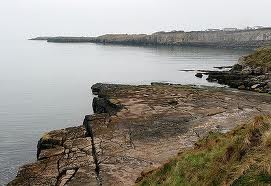 Todays post is inspired by one of my favorite songs, “Isaac Lewis”, by the brilliant singer/songwriter Tom Russell.
Todays post is inspired by one of my favorite songs, “Isaac Lewis”, by the brilliant singer/songwriter Tom Russell.
The Royal Charter was a steam clipper built and launched in 1855. Steam clippers were a new type of ship in the mid 1800s – iron hulls, with the lines and sails of a traditional wooden clipper, but also equipped with an auxiliary steam engine which could be used when suitable wind was not available. The Royal Charter was mainly used as a passenger ship between Liverpool and Australia, a trip she could make in under 60 days. She was capable of carrying 600 passengers, with a crew exceeding 100.
In October 1859, the Royal Charter was returning to Liverpool from Melbourne. Aboard were over 370 passengers and a crew of 112. Among the passengers were many gold miners, who were carrying large amounts of gold on their persons, as well as a large consignment of gold carried as cargo. On the night of October 26 the ship was caught in a storm later to be known as the “Royal Charter Gale”. Over 200 ships were lost to this storm. The Royal Charter attempted to anchor offshore of Porth Alerth to ride out the gale, but hurricane force winds caused the anchor chains to snap. Despite cutting the masts and use of the auxiliary engine, the ship was pushed into a sandbar near shore in the early morning hours. Several hours later the rising tide and gale force winds drove her on to the rocks at a point just north of Moelfre on the north coast of Angelsey. The Royal Charter was rapidly battered to pieces by the rocks. One crew member, Maltese born Guzi Ruggier also known as Joseph Rogers, was able to swim to shore with a line. 39 passengers and crew (all men) were able to be rescued. Over 450 others died, many lost at sea.
Monuments to the lives lost on the Royal Charter can be found on the cliffs above her final resting place and in a local cemetery, where the bodies that washed ashore over the next several weeks were buried. It is said that large quantities of gold were thrown up on the beach at Porth Alerth, with many local families becoming wealthy overnight as a result of the tragedy. Many pieces of wreckage of the ship can still be found at the base of the rocks at Moelfre, visible at low tide and to scuba divers.
Stories from shipwrecks often defy imagination. Perhaps few stories are as poignant as the story of Isaac Lewis. Lewis was a young man from northern Wales who sailed to Australia and back, only to die in the Royal Charter wreck. In the last moments of his life he was able to see his father on the headland, and legend says to shout “Oh father, I have come home to die”. Three days after the storm cleared the body of Isaac Lewis washed ashore in Wales, landing less than 100 yards from his father’s front door…
You can view Tom Russell performing his haunting tribute to Lewis by visiting the following link. After that I encourage you to explore more of the work of this truly gifted musician and poet.
http://www.youtube.com/watch?v=7ALfs81CFdE
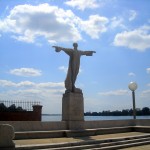
 An incredible amount of information is available on the loss of the Titanic in 1912. Thus it is not necessary to discuss the accident in this blog. Interest in the shipwreck itself, however, has increased of late due to a new photographic survey conducted this summer, focusing on parts of the ship’s remains not previously observed or photographed.
An incredible amount of information is available on the loss of the Titanic in 1912. Thus it is not necessary to discuss the accident in this blog. Interest in the shipwreck itself, however, has increased of late due to a new photographic survey conducted this summer, focusing on parts of the ship’s remains not previously observed or photographed.
Memorials to the victims can be found in a variety of locations around the world – including the United States, Canada, Ireland, the United Kingdom, and Australia. Many of these memorials will be covered in future posts. Today’s post will highlight a memorial that is probably not seen by many tourists in Washington, D.C. due to its location well outside the city center.
The Washington Titanic Memorial was unveiled in May 1931 by the widow of President Taft. It was designed by Gertrude Vanderbilt Whitney and sculpted by John Horrigan from a single piece of Rhode Island red granite. The original placement of the memorial was in Rock Creek Park along the Potomac River. In 1966 the memorial was removed to accommodate The Kennedy Center for the Performing Arts. In 1968 it was re-erected without any ceremony on the waterfront outside Ft. McNair.
An inscription can be found on the front and back of the memorial base. It reads:
